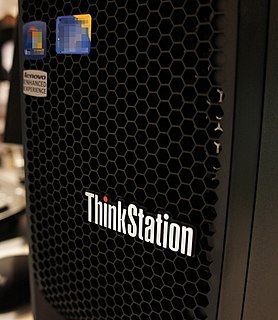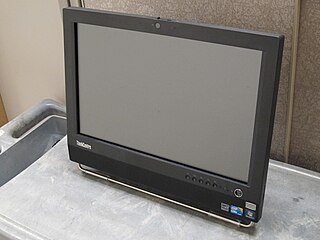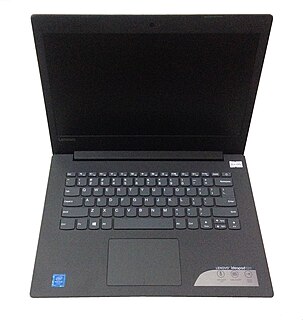Dell XPS is a line of high performance computers manufactured by Dell.

Dell Vostro is a line of computers from Dell aimed at small businesses. In 2013, the line was discontinued on some Dell websites but continued to be offered in other markets, such as Malaysia.

The Vaio S series was a line of notebook computers from Sony introduced in summer 2004. They have been touted as business laptops, and their designs have focused on being thin and light. They also have features friendly to businesspeople, such as TPM chips, matte (anti-glare) displays, RAID SSDs, and extended sheet batteries, as well as continuing to include RJ-45 and VGA (D-Sub) connections.
Sony VAIO AR series was a range of high-end multimedia notebook computers from Sony introduced in June 2006 as the first laptop with integrated Blu-ray drive. It replaced the AX Series. It featured a 17" 16:10 widescreen LCD screen, with choice of 1440x900 or 1920x1200 resolutions. It was replaced by the AW series.

The ThinkPad E Series is a notebook computer series introduced in 2010 by Lenovo. It is marketed to small and medium-sized businesses.

The ThinkPad X series is a line of notebook computers and convertible tablets originally produced by IBM and now marketed by Lenovo.

The ThinkPad W-series laptops from Lenovo are described by the manufacturer as being "mobile workstations", and suit that description by being physically on the larger side of the laptop spectrum, with screens ranging from 15" to 17" in size. Most W-series laptops offer high-end quad-core Intel processors with an integrated GPU as well as an Nvidia Quadro discrete GPU, utilizing Nvidia Optimus to switch between the two GPUs as required. Notable exceptions are the W500, which has ATI FireGL integrated workstation-class graphics, and the W550s, which is an Ultrabook-specification laptop with only a dual-core processor. The W-series laptops offer ISV certifications from various vendors such as Adobe Systems and Autodesk for CAD and 3D modeling software.
The first netbook in Lenovo’s IdeaPad S Series was launched in October 2008. The IdeaPad S10 was scheduled for launch in September but was delayed, with an estimated release date indicated as November 2008. Ultimately, the netbook was released in September in China, but in October in the United States.
The IdeaPad Z Series is designed primarily for entry-level multimedia users. The first three Z Series IdeaPad laptops were the Z360, Z460 and Z560, with 13 inch, 14 inch, and 15 inch screens respectively. All three laptops were released in 2010.
The first laptop in the IdeaPad U series was the U110 launched in 2008 by Lenovo. Showcased at CES 2008, the laptop also launched the IdeaPad series itself, and received the Best of CES 2008 award. The IdeaPad U series was a line of Lenovo’s consumer line of laptops, combining Lenovo’s traditional engineering with design changes that were significantly different from ThinkPad products.
The M-series desktops are part of Lenovo's ThinkCentre product line. Formerly an IBM brand, Lenovo acquired the ThinkCentre desktop brand following its purchase of IBM's Personal Computing Division (PCD) in 2005. Following its acquisition of IBM's PCD, Lenovo has released M-series desktops in multiple form factors, ranging from traditional tower, to small form factor, and all-in-ones (AIOs).
The IdeaCentre B Series all-in-one desktops from Lenovo were first launched in 2010. Like other desktops in the IdeaCentre product line, the B Series desktops were designed for home users, with a focus on the consumer PC segment. The first model in the series was the B500.
The IdeaCentre is a line of consumer-oriented desktop computers. The first IdeaCentre desktop, the IdeaCentre K210, was announced by Lenovo on June 30, 2008. While the IdeaCentre line consists entirely of desktops, they share a common design language with the IdeaPad line of laptops and hybrids. One such feature was Veriface facial recognition technology.
The IdeaCentre K Series desktops from Lenovo are described by the manufacturer as being gaming-oriented desktops. Typical features on the desktops include mid-range to high-end processors, discrete graphics cards, multiple hard disk drives, multiple RAM DIMMS, multiple USB ports, and multiple optical disk drives. The K Series desktops also come with a physical switch on the CPU that allows users to shift between different levels of processing power. For example, the K330 offered red for high performance, blue for moderate performance, and green for less processing- and resource-intensive tasks.
In addition to the ThinkPad and IdeaPad laptops, Lenovo also offers a value-priced series of laptops. Called ‘Essential’ on the Lenovo Web site, the products available in this line include the G Series, B Series, and V Series. Launched in 2009, the first laptop in the Essential range was the G530.
Lenovo’s line of ‘Essential’ desktops is a collection of budget-conscious machines designed for consumers, and advertised as being "affordable, space saving, and energy efficient". The Essential desktop line is different from both Lenovo’s ThinkCentre line and Lenovo’s IdeaCentre line. Lenovo defines its ThinkCentre desktops as business-oriented computers, while the IdeaCentre desktops are meant primarily for entertainment. The Essential range of desktops can be categorized as being between the two – meant more for ordinary everyday use.

The ThinkStation products from Lenovo are professional workstations designed for high-end computing. In 2008, Lenovo expanded the focus of its "THINK" brand to include workstations, with the ThinkStation S10 being the first model released. In 2014, Lenovo introduced the P Series workstations.

The ThinkCentre Edge is a series of desktop computer from Lenovo, designed primarily for home offices and small businesses. The product series features desktops in both tower and All-in-One form factors, designed to save up to 70% desk space as compared to traditional tower desktop PCs.
The Dell Inspiron series of laptop computers was introduced in 2000 as a consumer oriented line, available to the general public through electronics and department stores, contrasting to the business/enterprise-oriented Dell Latitude series of laptop computers, and are usually ordered from Dell directly via the website, phone, or mail-order.












